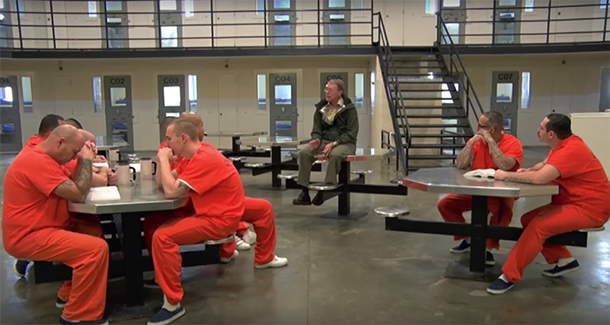
(Image from San Bernardino County Sheriff’s Department video)
Manuel was first arrested and booked in 1987 and has been arrested 63 times in total.* He is HIV positive and homeless when he’s not in custody. Before his last release, he worked with a dedicated team within the San Bernardino County Sheriff’s Department to help him successfully reenter society.
Formed last year, S.T.A.R.T. (Sheriff’s Transitional Assistance Reentry Team) is a two-person team assigned to West Valley Detention Center. It is dedicated to reducing the rate of re-arrests by helping inmates create a plan to reenter and connect to community resources and service providers before they are released. If needed, the team will transport the individuals directly to service providers upon release.
“We kept seeing a lot of the same inmates coming through the facility, almost daily or sometimes weekly,” said San Bernardino Sheriff Deputy Branden Davault, who created the program. “Because of my past experiences working on the street with the homeless outreach team (H.O.P.E) and noticing the high rate of recidivism and really no reentry services being offered, I realized that something needed to be done.”
A San Bernardino County jail study conducted by CA Fwd showed that ten percent of the people booked in 2015 had three or more bookings that year.
Deputy Davault worked with Captain Donny Mahoney to create a program that would stop high recidivism rates through an intelligent application of resources. They researched programs across the country and devised a program that would work well in San Bernardino County. The S.T.A.R.T. program currently consists of Deputy Davault and Sheriff’s Custody Specialist Heather Beidler.
The team identifies individuals in custody who have multiple bookings and other factors such as homelessness and alcohol or substance abuse. If a person is deemed a good candidate, the team will form a reentry plan and reach out to service providers in the county.
In its first year, the program has met with 1,068 incarcerated individuals. Of those, 717 were homeless, 226 were diagnosed with behavioral health issues and 89 were veterans. The current average caseload is about 250 for the two-person team.
When S.T.A.R.T. began a year ago, the team would go through a database to identify potential candidates for the program. Word of its success spread quickly among law enforcement and the inmates.
“We’ve definitely seen a shift. When we first started, we had to seek out the inmates. Now they come to us,” said Specialist Beidler, who noted that they get 20-30 requests a week. “They’re seeing that law enforcement support also, which is a good thing because it might change their view a little bit.”
The team has found housing for 95 individuals, given referrals to 555 and assisted 398 with various resources. Their goal is to provide something to each person who reaches out to them from finding housing and medical services to giving them a guide to county resources.
Added Specialist Beidler, “Every single individual we speak to, we try to help them in some kind of way. Even if it’s not someone who is a high utilizer of the system, even if it’s just getting them that DMV form because they need it to get a job.”
One of the many successes of S.T.A.R.T. is the collaboration with other county agencies and city police departments. The team works closely with Corrections to a Safer Community (CTASC) to assist individuals with mental health needs. It also works with independent police departments who can identify people who are arrested and booked often.
“That’s had a lot of buy-in from the outside departments because now they’re able to see that it’s not just about arrest, arrest, arrest,” said Deputy Davault. “It’s about getting this person off the street and stopping him from becoming a ‘time-consumer.’ Let’s take him from a ‘tax-taker’ to a ‘tax-maker.’”
Looking forward, the S.T.A.R.T. program has plans to double the amount of individuals it assists. It is also looking to institute case conferencing. This is when service providers, law enforcement and other entities come together to determine the best treatment of care for individuals who cycle in and out of jail. It is often the case that these same people frequently use emergency rooms, treatment centers and other services.
“We’re really excited about the future. We’ve exceeded our expectations and both of us can say that we’re very proud of this program,” said Specialist Beidler.
As for Manuel, since his release, he has entered a medical program that specializes in HIV/AIDS treatment and includes housing. Also, Manuel has been in good standing with his probation terms, which means he hasn’t returned to jail.
*The individual's name has been changed to protect his privacy.

